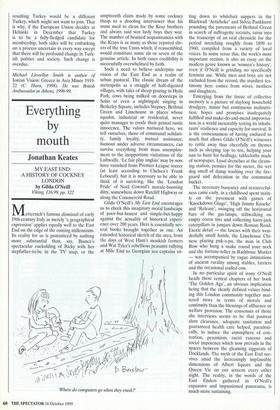Everything by mouth
Jonathan Keates MY EAST END: A HISTORY OF COCKNEY LONDON by GiIda O'Neill Viking, 116.99, pp. 322 Mettemich's famous dismissal of early 19th-century Italy as merely 'a geographical expression' applies equally well to the East End on the edge of the coming millennium. Its reality for us is guaranteed by nothing more substantial than, say, Bianca's spectacular cuckolding of Ricky with her stepfather-to-be in the TV soap, or the
umpteenth claim made by some cockney thesp to a drooling interviewer that his mum used to clean for the Kray brothers and always said wot luvly boys they woz. The number of boasted acquaintances with the 'Crays is as many as those reputed sliv- ers of the true Cross which, if reassembled, would constitute some six or seven of the genuine article. In both cases credibility is successfully overwhelmed by faith.
Such a need to believe underpins our vision of the East End as a realm of urban pastoral. The classic dream of the metropolis as a straggle of half-digested villages, with tales of sheep grazing in Hyde Park, cows being milked on doorsteps in Soho or even a nightingale singing in Berkeley Square, includes Stepney, Bethnal Green and Limehouse as places whose squalor, industrial or residential, never quite manages to erode their primal rustic innocence. The values nurtured here, we tell ourselves, those of communal solidari- ty, family loyalty, mutual assistance, humour under adverse circumstances, can survive everything from mass unemploy- ment to the inopportune visitations of the Luftwaffe. 'i.e fair play anglais' may by now have vanished from Premier League soccer (at least according to Chelsea's Frank Leboeuf), but it is necessary to be able to think of it surviving, like the 'London Pride' of Noel Coward's morale-boosting ditty, somewhere down Ratcliff Highway or along the Commercial Road, Gilds O'Neill's My East End encourages us to check this imaginary moral landscape of poor-but-honest and simple-but-happy against the actuality of historical experi- ence over 200 years. Hers is essentially sev- eral books brought together as one. An extended historical sketch of the area, from the days of West Ham's monkish farmers and Wat Tyler's rebellious peasants rallying at Mile End to Georgian sea captains sit-
ting down to whitebait suppers in the Blackwall 'Artichoke' and Sylvia Pankhurst pounding the pavements of Bethnal Green in search of suffragette recruits, turns into the transcript of an oral chronicle for the period stretching roughly from 1890 to 1960, compiled from a variety of local voices. In some sense this, the work's most important section, is also an essay on the modern genre known as 'women's history', even if O'Neill is grinding no specifically feminist axe. While men and boys are not excluded from the record, the sturdiest tes- timony here comes from wives, mothers and daughters.
Emerging from the tissue of collective memory is a picture of daylong household drudgery, minor but continuous malnutri- tion, hopes and promises inadequately fulfilled and make-do-and-mend improvisa- tion in a world inexorably testing its inhabi- tants' resilience and capacity for survival. It is the consciousness of having endured so much that allows Gilda O'Neill's witnesses to rattle away thus cheerfully on themes such as sleeping top to toe, helping your nan to hunt for bedbugs, tablecloths made of newspaper, Lysol drenches at the cleans- ing station, pennies for the meter, the wet dog smell of damp washing over the fire- guard and defecation in the communal bucket.
The necessary buoyancy and resourceful- ness came early, in a childhood spent main- ly on the pavement with games of 'Knockdown Ginge', 'High Jimmy Knacke' and 'Release', swinging off the horizontal bars of the gas-lamps, stiltwalking on empty cocoa tins and collecting hairy-jack caterpillars in jamjars down Roman Road. Exotic detail — the lascars with their won- derfully small hands, the Limehouse Chi- nese playing puk-a-pu, the man in Club Row who hung a snake round your neck and the fortune-teller in Rathbone Market — was accompanied by vague intimations of ancient rurality among stables, farriers and the occasional stalled cow.
In no particular spirit of irony O'Neill heads these central chapters of her book 'The Golden Age', an obvious implication being that the clearly defined values bind- ing this London community together mat- tered more in terms of morale and continuity than the blessings of affluence or welfare provision. The consensus of those she interviews seems to be that postwar slum clearance, adequate sanitation and guaranteed health care helped, paradoxi- cally, to induce the atmosphere of con- tention, pessimism, racist rancour and social impotence which now prevails in the spaces between the gleaming ziggurats of Docklands. The myth of the East End sur- vives amid the increasingly implausible dimensions of Albert Square and the Queen Vic on our screens every other night. The reality, in the words of the East Enders gathered in O'Neill's expansive and impassioned panorama, is much more sustaining.


















































































 Previous page
Previous page